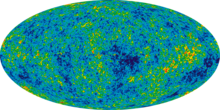
Back نظرية الحالة الثابتة Arabic Теория на стационарната Вселена Bulgarian Teoria de l'estat estacionari Catalan Teorie ustáleného stavu Czech Steady State-teorien Danish Steady-State-Theorie German Κοσμολογία της Συνεχούς Δημιουργίας Greek Teoría del estado estacionario Spanish Egoera geldikorraren teoria Basque نظریه حالت پایدار Persian
| Part of a series on |
| Physical cosmology |
|---|
 |

In cosmology, the steady-state model or steady state theory is an alternative to the Big Bang theory. In the steady-state model, the density of matter in the expanding universe remains unchanged due to a continuous creation of matter, thus adhering to the perfect cosmological principle, a principle that says that the observable universe is always the same at any time and any place.
From the 1940s to the 1960s, the astrophysical community was divided between supporters of the Big Bang theory and supporters of the steady-state theory. The steady-state model is now rejected by most cosmologists, astrophysicists, and astronomers.[1] The observational evidence points to a hot Big Bang cosmology with a finite age of the universe, which the steady-state model does not predict.[2]
- ^ Kragh, Helge (1999). Cosmology and Controversy: The Historical Development of Two Theories of the Universe. Princeton University Press. ISBN 978-0-691-02623-7.
- ^ "Steady State theory". BBC. Retrieved January 11, 2015.
[T]he Steady State theorists' ideas are largely discredited today...
© MMXXIII Rich X Search. We shall prevail. All rights reserved. Rich X Search